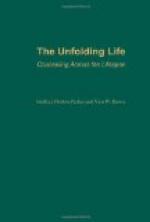The increasing love of a story discloses a growing imagination. The passionate hero worship of a boy’s heart reveals the fact of a budding ideal. The interest in clubs and desire for companionship tell of awakening social feelings. Life is always the exponent of its own need to one who cares to know, and it further reveals what should be given it, and how.
VI. The Sixth Principle has already been touched upon in the preceding discussion, but it needs the emphasis of special statement, because of its importance. “Development is from within, out, through what is absorbed, not from without, in, through external application without absorption.”
If development were a matter of external application, the post would grow and the stone and the stick, because they have earth and air and moisture around them. If it came from without, in, the most admonished child would be the best, the most talked to pupil the wisest, but the reverse is usually true. That which adheres simply to the surface of rock and child is veneer, which the testing circumstance will rub off. Only that which is assimilated is of any value to the life.
These are the great principles revealed in the development of life from infancy to maturity. The factor of human contact appears in every one. The question, “What is my touch upon this unfolding life?” can not be evaded. The stonecutter takes the marble and hews out the rough block; the sculptor finds its hidden soul. The artisan takes the canvas and the common sign appears; the artist makes it immortal. But God gives life to parents and teachers to fashion. Will hands clumsy and unskilled, miss the perfect beauty, or the touch of master workmanship bring forth a likeness to the Christ?
CHAPTER II
EARLY CHILDHOOD
The first period of life, Early Childhood, includes the years from birth to about six or, in Sunday School phraseology, the “Cradle Roll,” from birth to three, and the “Beginners,” from three to six.
It is a temptation to note at length the marvelous achievements of a little life in its earliest years, as it comes,
“Out from the shore of the
great unknown,
Blind and wailing and alone,
Into the light of day.
* * * * *.
“From the unknown sea that reels and rolls,
Specked with the barks of little souls,
Barks that were launched on the other side,
And slipped from Heaven on an ebbing tide.”
The wealth of material, however, clustering around each period of developing life is so great that selection must be made. Therefore only those facts illuminating the chosen theme of religious nurture will be considered.
The baby’s world is a “big, blooming, buzzing confusion,” according to James, but gradually, cosmos emerges from chaos. The senses, clouded at first, become clear and active. Adjustment and voluntary control of the larger muscles are secured. The art of walking is mastered, and the great feat of learning a language practically unaided, is well under way. The awakening mind learns to know certain objects and simplest relationships within a very limited sphere, and through ceaseless activity, new experiences are constantly coming in to the soul.




